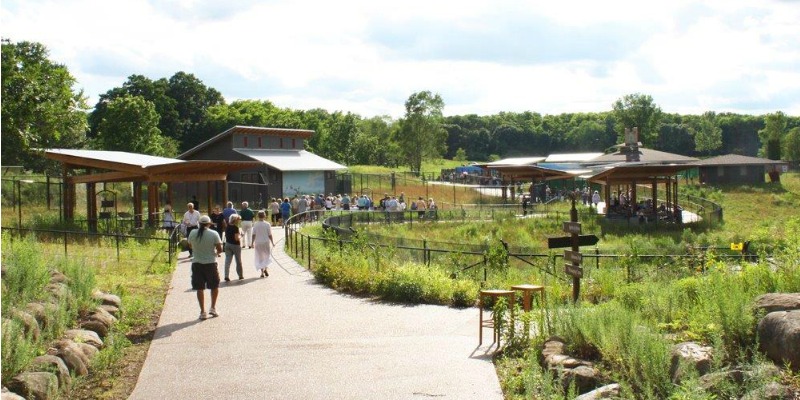THE BARABOO AREA’S ENVIRONMENTAL MECCAS
Just north of Madison, naturalists and the just plain inquisitive can peek into one of the world’s most tenacious efforts to pluck nearly a dozen bird species from the jaws of extinction, and keep a few other relatively abundant species from becoming vulnerable.
In fact, were it not for the International Crane Foundation in Baraboo and other key East Coast and Canadian efforts, the endangered whooping crane would be long gone. Hunting, habitat loss and other pressures left just 21 whooping cranes in the wild in the 1940s. Today there are some 400 wild whoopers, many of which summer in Canada and certain Wisconsin wetlands.
About 200 birds are in captive breeding programs, including the foundation’s current 30 pairs. One female was sitting on an egg during a recent tour in April. The center’s cranes typically produce 10 to 20 chicks per year for reintroduction into the wild and genetic species management.
The center’s efforts are important beyond the survival of crane species, external affairs director Betsy Didrickson says.
“The health of crane species worldwide are vital indicators of the health of landscapes and natural resources that benefit all life,” Didrickson says.
The International Crane Foundation houses 15 species of cranes, some standing as tall as 6 feet. Many cultures revere cranes as sacred symbols of longevity, monogamy and good luck.
Despite the supposed reverence for these lanky and long-lived birds, nearly all 15 species are classified as vulnerable to extinction. Others, such as the grey-crowned and red-crowned cranes, are listed as endangered and the Siberian crane is critically endangered.
“Cranes live in a world increasingly filled with people, often restless to exploit the last wild areas of the planet,” Didrickson says.
The International Crane Foundation also houses sandhill cranes, relatively common in this region but which face a new threat in Wisconsin. The public voted in the state’s recent conservation congress to create an annual sandhill crane hunting season, and aside from renewing the assault on this once-scarce bird, foundation experts worry that whooping cranes may be mistaken for sandhills in the hunt.
The foundation’s experts lead several public tours a day. A twohour tour offers an in-depth look at the myriad threats cranes face worldwide and the group’s conservation efforts with partners around the globe. The center has specialists in over 50 countries on five continents.
A visit to the Baraboo center is also a chance to stand nearly eye to eye with some of the majestic birds, who chortle their prehistoric sounding calls, dance a few steps in their mating rituals, and puff up their head feathers and darken their red caps or masks in obvious affront to the gawking humans.
The center’s gift shop offers a refreshing variety of quality keepsakes, including lots of locally made prints, cards and jewelry, as well as some fair trade clothing from Nepal and namesake T-shirts and caps.
The foundation is but one stop along Highway 12 ranking on many environmentalists’ life lists. The Aldo Leopold Foundation, whose property includes the pioneering naturalist’s shack, made famous in his seminal book “A Sand County Almanac,” is just down the road from the crane haven.
There, visitors can take tours, classes and join in other events to learn about the conservationist who developed the groundbreaking idea of a land ethic—a caring, ethical relationship between people and nature.
The shack is an abandoned chicken coop where Leopold and his family lived on weekends and where they began studying ways to transform a once worn-out property into a thriving, productive landscape.
And there are plenty of other natural sights to turn the trip into a weekend adventure, including the red rocks and and chilly depths at Devil’s Lake State Park. Plus, the surrounding Baraboo Hills also play host to some 135 avian species and 10,000 migrating birds each spring and fall. savingcranes.org. aldoleopold.org.
Neither the Leopold nor the crane foundations offer restaurants on site, so it’s best to pack a lunch or take a turn into Baraboo proper if you want more than snacks to fortify you on your adventure. The Driftless Glen, a restaurant and distillery, has a variety of burgers and flatbread sandwiches on the menu, along with its own rye and bourbon to include in cocktails or buy by the bottle. Jen’s Alpine Café is a soup and sandwich place, with quaint alpine-style booths, that also offers hearty comfort foods such as chicken and dumplings.





Comments are closed.